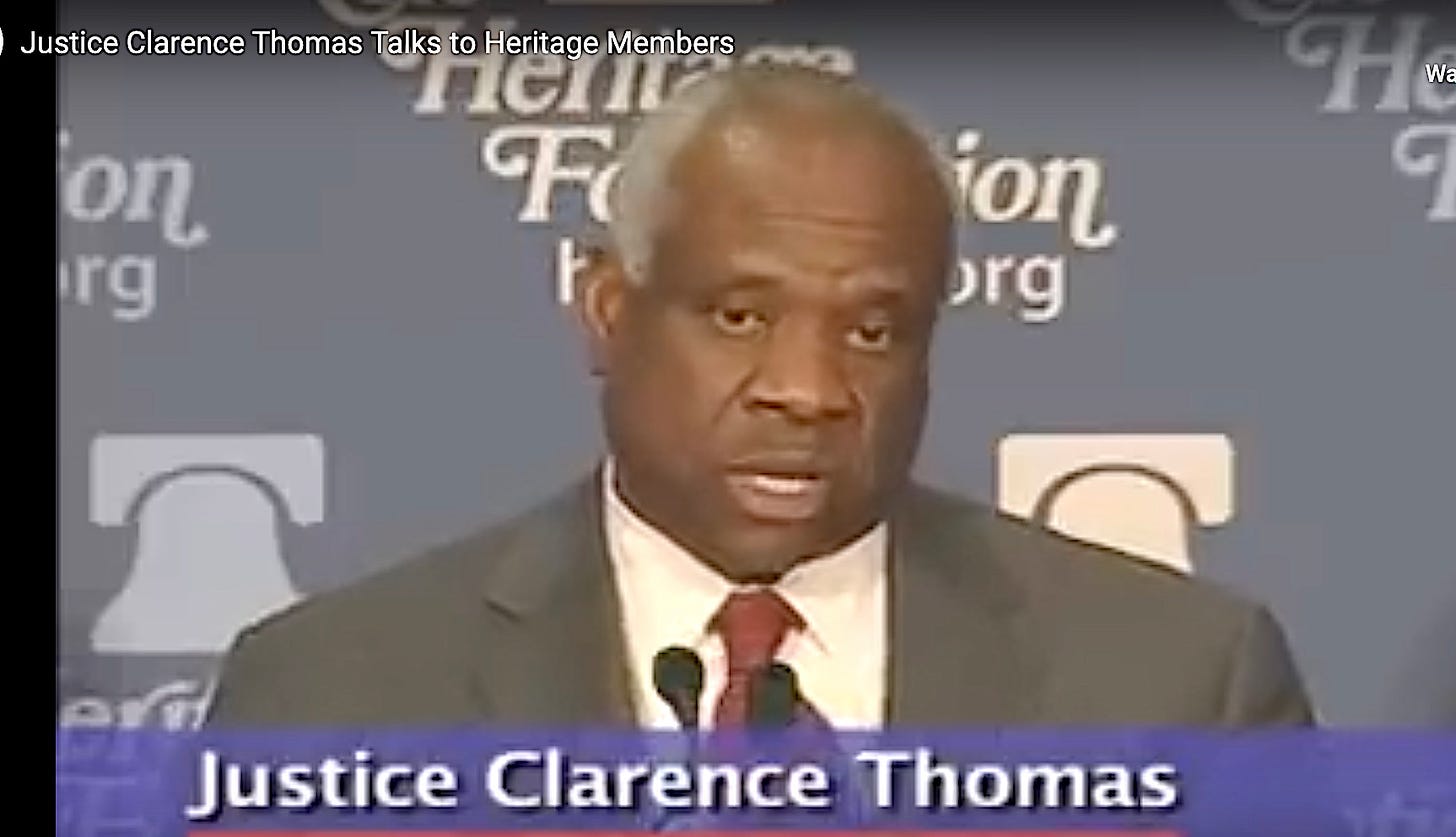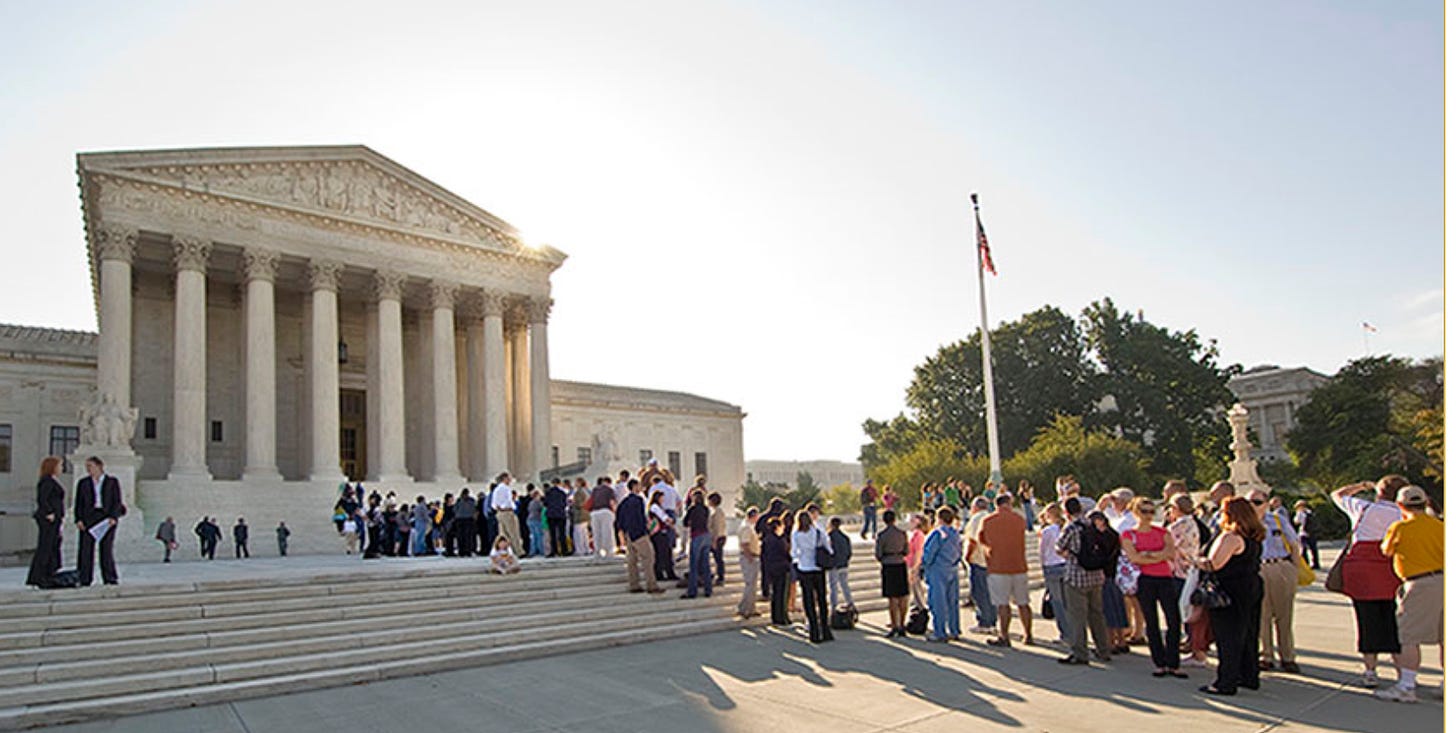Clarence Thomas, the Roberts Court, and the corruptions of our American Dreams (Part 2 of 2)
July 10, 2024
American bison and the front range of the Rockies, Adams County, Colorado
A Promise, For All of Us
Part 2, The Reckoning
If you could describe my adopted home town with a political color, it would be purple. Spokane, WA, is bluer toward the middle, where I live, and this attracts out-of-towners, in pickup trucks, who fly a Trump flag from one side of the tailgate, and the Stars & Stripes from the other. It is their wish to be seen, and heard.
For the engine-revving drivers, the flags complement each other. For me their meanings couldn’t be further apart. The Stars & Stripes symbolize a proud but imperfect nation, working through fits and starts, for the good of all. The Trump flag is a battle flag for the “retribution” of the culture war—eager for the day we televise Liz Cheney’s treason trial before a military tribunal.
Clarence Thomas addressing a Heritage Foundation gathering in 2007 (source, YouTube)
The New York Times first reported on the unusual relationship between Clarence Thomas and Texas billionaire Harlan Crow 13 years ago. At the time the story’s focus was on large gifts Crow was making to a “project” of Thomas’s at Thomas’s birthplace in Pin Point, Georgia, on the coast not far from Savannah. In the course of the story, the Times also reported on personal favors, including sizable sums of money Crow had bestowed directly to Thomas and his family members—such as the half million dollars funneled to Thomas’s wife Ginni to start a right-wing political group. The Times also provided evidence that Thomas had received free flights on Crow’s private plane and travel on his yacht, but had not reported the gifts on his legally required disclosures.
One might think scrutiny from the nation’s premier newspaper would be a signal both to Thomas and the court as a whole to address what were at least the appearances of ethical impropriety and violations of disclosure requirements. But no. A decade later Pro-Publica, a non-profit investigative reporting project, won the 2024 Pulitzer Prize for Public Service for its Friends of the Court series. The reporting picked up the threads of Thomas’s continuing unethical conduct, and continued failures to report large gifts and payments from Crow.
Pro-Publica’s investigation also netted Justice Samuel Alito posing with a freshly caught Alaskan salmon next to billionaire hedge fund manager Paul Singer, a frequent petitioner before the Supreme Court. According to Pro-Publica, Singer had paid all of Alito’s expenses for the trip, including his air travel and Alaskan lodging. The reporters estimated the value (to Alito) of the adventure at well over $100,000. Justice Alito, like Thomas, was required to report the gifts, but didn’t. Nor did Alito recuse himself from a 2014 case directly involving Singer, in which Alito joined a majority ruling on Singer’s behalf—a ruling that was highly lucrative for Singer.
A year after the Jan. 6, 2021 insurrection—Jane Mayer, one the nation’s most acclaimed investigative reporters—delivered a piece for the New Yorker entitled “Is Ginni Thomas a Threat to the Supreme Court?” What Mayer’s reporting detailed is that the highly-partisan political activity of Clarence Thomas’s wife had only escalated with the rise of Donald Trump. Not only was Ginni Thomas active on Trump’s behalf as an activist convener and consultant, but she was also in close contact with Mark Meadows, Trump’s Chief of Staff, in the run-up to the 2021 insurrection. The most compelling evidence—powerfully corroborating Mayer’s article—was disclosed in text messages from Ginni Thomas that came to light shortly after Mayer’s article was published.
Even before the Roberts Court put the brakes on the Trump v. United States trial in Judge Tanya Chutkan’s courtroom, the Supreme Court’s standing in public opinion had sunk to a historic low, with public disapproval approaching 60 percent in the most recent Gallup survey.
Here’s one of the text messages. It reflects the flavor of the others.
11/10/2020 (one week after the 2020 election) Ginni Thomas to Meadows: “Help This Great President stand firm, Mark!!! ... You are the leader, with him, who is standing for America's constitutional governance at the precipice. The majority knows Biden and the Left is attempting the greatest Heist of our History.”
To which Meadows responded that day: "I will stand firm. We will fight until there is no fight left. Our country is too precious to give up on. Thanks for all you do.”
The situation involving Alito and his wife is less blatant but, under traditional ethical standards for the judiciary, still raises the appearance of a conflict of interest that would warrant recusal from a case. It evolved from reporting that the Alitos were flying an upside-down American flag at their northern Virginia home in the aftermath of the Jan. 6, 2021 insurrection at the Capitol.
The stars-down flag (a longstanding symbol of distress) was basically re-purposed by those who supported the 1/6/21 insurrection or claims that the election was stolen from Trump. When Justice Alito finally spoke about it, he didn’t dispute the gesture’s association with the pro-Trump cause. He just said he had nothing to do with it; that it was flown at the insistence of his wife, Martha-Ann, in response to a conflict with a neighbor who was displaying an anti-Trump sign. The controversy thickened when it was also revealed the Alitos were flying the “Appeal to Heaven” flag—brandished during the attack on the Capitol and associated with the pro-Trump Christian Nationalist movement—at their New Jersey beach house last summer. Alito again said it was his wife’s idea but added that neither were aware of its pro-insurrection symbolism.
There remain unanswered questions about the Alitos explanations. But there’s no question their flag-flying argues for ethical scrutiny in which the integrity and public credibility of the tribunal is (or ought to be) the overriding consideration.
The Supreme Court Building in Washington, D.C. (photo courtesy Wikimedia images)
But who decides? The Supreme Court is unique in this respect. It’s the individual justices themselves who get to determine whether or not their own conduct comports with ethical canons.
The contemporary code of conduct for federal judges clearly stipulates that judges should avoid even the appearance of impropriety, including conflicts of interest and bias. It pertains to both professional and personal conduct. Consequently, Alito received appeals from several prominent Democrats—including Dick Durbin, the chairman of the Senate Judiciary Committee—to recuse himself from cases involving Donald Trump and insurrectionists involved in criminal proceedings. Alito refused to do so, and was immediately applauded by Trump for “showing the INTELLIGENCE, COURAGE, and ‘GUTS’ to refuse to step aside from making a decision on anything Jan. 6, related.”
When Chief Justice Roberts’ announced a new code of conduct for the Supremes last November (obviously in response to the Pro-Publica reporting on Thomas and Alito) it came with at least a couple key escape clauses.
1) It is only self-enforcing: the judges themselves are left to decide whether or not they should recuse themselves from cases in which they have a conflict, or the appearance of a conflict.
2) Even if a justice determines he or she ought to disqualify themselves for bias, that determination can be over-ridden by “the rule of necessity” within which the judge may determine that his/her participation is irreplaceable in effecting the resolution of the case before the court.
If this seems like minutiea, it’s not.
Even before the Roberts Court put the brakes on the Trump v. United States trial in Judge Tanya Chutkan’s courtroom, the Supreme Court’s standing in public opinion had sunk to a historic low, with public disapproval approaching 60 percent in the most recent Gallup survey.
More importantly—and perhaps most importantly—Thomas and Alito’s recusals may have resulted in a much different outcome than the one the court delivered on July 1st. If the majority’s 6-3 decision was winnowed to 4-3 by their warranted recusals, the swing vote would have been Justice Amy Coney Barrett. Though Coney Barrett sided with the majority in most of the opinion, shet took the unusual step of joining Justice Sonya Sotomayer’s dissent on a crucial point. Coney Barrett strongly disagreed with the majority’s finding that the breadth of a president’s immunity for “official acts” precludes criminal inquiry into the president’s motivation and conduct when he/she is acting in their official capacity.
A Brazen Power Grab
To continue reading, please subscribe to The Daily Rhubarb and support it with a monthly or yearly subscription fee via the link below. Reader support is essential and greatly appreciated—tjc












That looks like an old moose. Thanks for your report